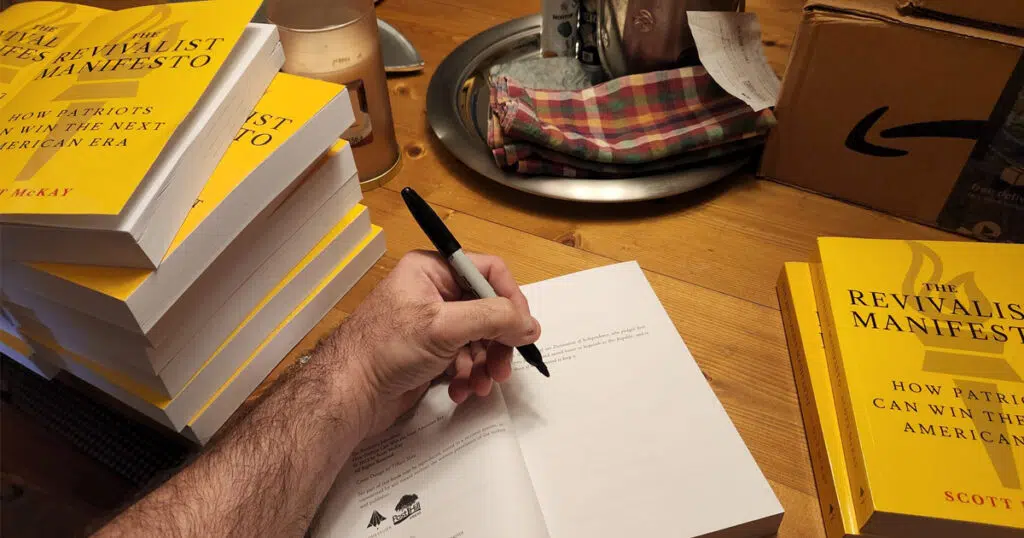
America’s Fourth Political Era Must Begin On Nov. 8
Those of our readers who’ve already read my new book The Revivalist Manifesto, currently available at Amazon in paperback and e-book format with an audiobook version coming soon, are familiar with the construct suggested by the headline above.
For those who haven’t read the book, I’ll briefly describe it.
We are nearing the end, the overdue end at that, of the Third Era of American political history.
The First Era came into being with the 1800 presidential election, the one in which Thomas Jefferson throttled John Adams to become America’s third president. That election, which was a repudiation of the highly-unpopular Adams (he wasn’t a bad president, but he presided over some rough times and did some very unpopular things), set the stage for a generation of electoral dominance by what became the Democratic Party; Adams’ Federalist Party would ultimately disintegrate, and Democrats would go on to thoroughly dominate American politics for the 60 years that followed.
But all of the institutions and practices established to weld together the political consensus of that First Era ultimately came apart under the weight of technological and social change, not to mention the growing national crisis over the existence of slavery, and after a truly horrific president in James Buchanan oversaw a catastrophic four years leading up to the 1860 election, that era came to a halt.
Abraham Lincoln’s election in 1860 began the Second Era. And while the First Era was dominated by Democrats, the Second was a Republican era. The new party won every presidential election from 1860 to 1884 and it was Republican politics which shaped the national consensus. We became an intensely capitalist country governed by the free market, we expanded to fill what’s now the continental U.S., government grew but remained a tiny part of our national economy and was largely focused on expanding trade and building infrastructure and the Industrial Revolution found its home on our shores.
The only Democrat president of consequence in the Second Era was Woodrow Wilson. But shortly after his term ended with the 1920 election almost all of Wilson’s presidential legacy had been swept aside…
…until the Second Era collapsed under the catastrophic presidency of Herbert Hoover, whose awful decision-making turned a steep recession into an economic depression and paved the way for Franklin Delano Roosevelt to crush him in the 1932 election. That began the Third Era, the one we’re currently at the end of.
The Third Era has been marked by a political consensus in favor of things like the modern welfare state and regulatory state, foreign adventurism, first out of necessity in World War II and the Cold War but in endless wars of choice since, globalism, the military-industrial complex, the media-political complex and the medical-governmental complex. Arguably the most successful presidencies of the era have been Republican ones – Ronald Reagan, Dwight Eisenhower and Richard Nixon (from a foreign-policy perspective if not domestic) – but it’s nevertheless a Democrat era.
The consensus has been forged between William F. Buckley conservatives and Daniel Patrick Moynihan liberals, who largely agreed on the social goods government must convey and then set to quibbling over how best to convey them.
But like the previous two eras in American history, the institutions and practices of the Third Era have become corrupted and obsolete and no longer fulfill the country’s needs, and this era is coming to a close.
Most notably, the consensus of the era no longer exists, because the Buckleys and Moynihans no longer exist. The fusionist conservatism of the Third Era is mostly out of style on the Right, in chief because of its failures with respect to American culture but also for its overcautious and submissive political style. And on the Left, the Moynihans have been routed out of the institutions they formerly controlled by the Hard Left.
Naturally, we also have in Joe Biden the fundamentally, transformatively awful president who, like Buchanan and Hoover particularly, is just terrible enough to end one era and spark the creation of a new one.
And it will either be the Hard Left, or the America First/MAGA/revivalist conservatives who are ascendant on the Right and rapidly taking over the Republican Party, who sets our next political consensus and launches the Fourth Era of American politics out of the ruins of the Third Era.
On Nov. 8 America will have a key test of this thesis. We’ve had essentially a preseason over the last three or four political election cycles, with the surprise victory of Donald Trump in 2016 heralding the rejection within the Republican Party of what Buckley conservatism had become (something I’m confident Buckley himself would have been happy to see) and the 2018 and 2020 cycles offering some blowback for Trump’s political style and the system attempting to shrug him off, but more importantly for what has happened to the Democrat Party in those two cycles, in which the Hard Left has consolidated control of the party.
And now, though there are still Third Era politicians in prominent places in both parties, there is no question the active ingredients on both sides have become MAGA/revivalism on the Right and woke communism on the Left.
America will choose revivalism. Of that I’m confident. What is unknown is whether the Republican Party can grow into its proper role of become a vessel for revivalism to start the Fourth Era, or at least in time to prevent the Left from stealing it away.
The Revivalist Manifesto discusses the Fourth Era and what it can look like, as well as the history which produced this moment. Buy it at Amazon today!



